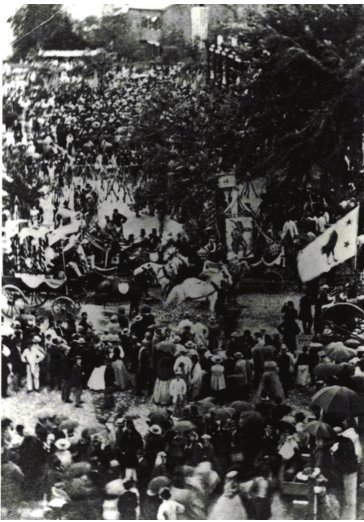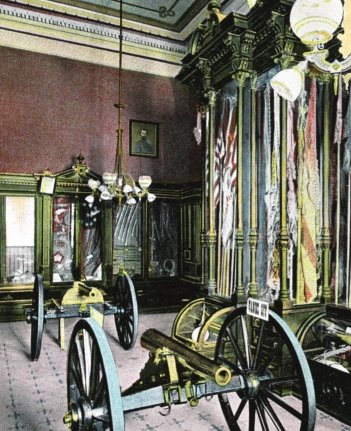These lyrics, from George Frederick Root’s 1862 song “Battle Cry of Freedom,” were more than just patriotic fluff for the battle-tested Union forces during the Civil War. Each regiment of 1,000 men had a color guard that carried an individualized regimental flag into battle.
The flags, 6 by 6 and a half feet and carried on 10-foot staffs, were colorful and emblazoned with inspirational sayings, such as “We conquer in right.” But beyond the patriotic messaging, flags identifying individual units were a necessity in the heat of battle, when the battlefield became a cacophony of rifle and artillery fire with disorganized troops running in every direction. Battle flags, held high or stuck in the ground, helped the regiments hold their ranks and advance the battle plan.

The flags were also an easy target for Confederate sharpshooters and artillery, so the mortality rate of flag bearers was high.
“Carrying the flag was a death sentence,” said Matt VanAcker, Capitol tour and information service director for Michigan and an expert on Michigan Civil War battle flags.
At the end of the Civil War, 150 years ago, regiments from Michigan returned home and presented the flags to the governor to celebrate the Union’s victory. Historians, state officials and military veterans will mark this anniversary Saturday with a full day of events that includes a recreation of the soldiers’ return from battle.
The flag bearer, VanAcker said, was “arguably more important than generals.”
“Flag bearers were not only chosen for their height and strength, but also their moral bearing,” he said. “Even though the position was perilous, the flag bearer knew and recognized it. It was one of the highest honors to carry the flag.”
The battle flags are often associated with acts of bravery. During one day at the Battle of Gettysburg, for example, the 24th Michigan Voluntary Infantry Regiment sustained incredible casualties. The flag bearer, Sgt. Abel Peck, from the Detroit area, was the first to fall. The flag was picked up by eight others, all of whom were killed in that battle or died later from their wounds. The regiment, nicknamed the “Blackhats” for its non-traditional headgear, was also called the “Iron Brigade” based on stories of its unbending strength. Of the 496 men who entered battle that day, 399 were killed, wounded or missing by the end of the day.
At the end of the war, the battle-worn flags were turned over to the State of Michigan for preservation and display. Many of the flags carry streamers listing significant battles. Some were handmade, such as the 7th Michigan Cavalry’s flag, which was made by the nuns of St. Mary Parish in Monroe.
“After four years of bloody war, the flags symbolized the heroes and the sacrifices they endured.” said Jack Dempsey, president of the Michigan Historical Commission and author of “Michigan and the Civil War.” Of the 90,000 Michigan soldiers who fought in the Civil War, 15,000 were killed.
On July 4, 1886, more than 70,000 veterans and tourists — an estimated 8 percent of the state’s population — gathered in Detroit at Campus Martius to watch Gov. Henry Crapo accept the flags from returning soldiers. More than 100 flags, in various states of deterioration, were handed over for care. Many of the flags were peppered by gunfire or stained by blood and grime, others were little more than tattered fragments.
The flags were eventually brought to the Capitol in Lansing, where they were on display for many years just off the rotunda in a military museum. The flags were later moved to the rotunda and placed under glass. It was quite a sight, but, from a preservationist’s point of view, it was not the best way to display the historic flags.
Gravity and light hastened the flags’ deterioration. In 1989, a Save the Flags committee was formed to protect the historical items. The original flags were replaced with replicas and moved to a humidity- and lightcontrolled site at the Michigan Historical Museum. The museum holds 160 Civil War-era flags, as well as 60 other flags from later wars.
The committee is working to professionally restore the Civil War flags, but that’s no easy feat. This type of careful restoration, VanAcker said, averages $10,000 per flag. So far, 14 flags have been sent out for restoration, and at least a dozen more would benefit from restoration. Individuals or groups are able to adopt a flag, at a minimum price $1000, and two adoption ceremonies will be held during Saturday’s reenactment.
Following the return of the flags in 1886, the veterans, estimated to be in excess of 35,000, were treated to a lunch at Michigan Central Station. Across the city, there were parades, circuses and special events to honor the returning troops and celebrate the end of the war. Saturday’s organizers are hoping to give visitors a small taste of the pomp and circumstance.

The event features two military bands, Civil War reenactors, speeches — probably not as flowery or as long as those during the original ceremony, thankfully — and a symbolic return of replica regimental flags by the Michigan re-enactors. Other attractions include a battery demonstration, a firing of a cannon and a demonstrations of an infantry drill and musket firing. Guests are encouraged to bring lawn chairs, blankets and picnic lunches.
The will likely be mention of Lansing’s most noted flag bearer, Charles T. Foster. On April 13, 1861, the day after the fall of Fort Sumpter, Lansing’s leading citizens held a rally to recruit volunteers. Foster was the first to step forward, followed by 30 others. After fighting in the battles of Bull Run and the Siege of Yorktown, Foster volunteered to carry the flag. Shortly after, at the Battle of Fair Oaks in May, 1862, Foster was mortally wounded but still managed to stick the flag in the ground, calling out, “Don’t let the colors go down!” Following the war, the local Grand Army of the Republic Lansing post was named in his honor. Foster’s home at 317 Chestnut St. still stands.
As part of Saturday’s festivities, a life-size, chain-saw-carved wooden sculpture, “The Men of the 14th,” by Gary Arens of DeWitt, will be on display. Arens’ statue, one of the 25 finalists in the 2015 ArtPrize contest, includes his great-grandfather Anthony Arens. The 14th is noted for participating in numerous bloody battles, including Sherman’s March to the Sea.
VanAcker said the committee is still looking for some Civil War flags. Of the approximately 160 flags carried by Michigan regiments in the Civil War, 125 were turned in to the state in 1866. Some flags were cut up and given to key members of a regiment. VanAcker was once contacted by a couple who had retrieved a flag, the flag of the 13th Battery, First Michigan Light Artillery Regiment, from the garbage while helping a neighbor move. The flags are extremely valuable. One noted flag, a guidon from Custer’s Little Big Horn debacle, sold for $2.2 million when the Detroit Institute for the Arts deaccessed it in 2010.
In a salute to one of the state’s Civil War heroes — James Vernor, a Detroit resident and pharmacist — free samples of Vernors ginger ale and Boston coolers will be served to those in attendance Saturday. Vernor was a member of the Fourth Michigan Cavalry and served in the detachment that captured Jefferson Davis. Legend has it that Vernor created his famous concoction by putting an experimental ginger ale syrup in an oak barrel before going off to war. When he returned home, he opened the keg, and one of Michigan’s best known drinks was born.
150th Anniversary of the Return of the Civil War Volunteers and Their Battle Flags
10 a.m.-3 p.m. Saturday, July 9 FREE Michigan State Capitol 100 N. Capitol Ave., Lansing (517) 373-5157, capitol. michigan.gov/battleflagflier
Support City Pulse - Donate Today!
Comments
No comments on this item Please log in to comment by clicking here